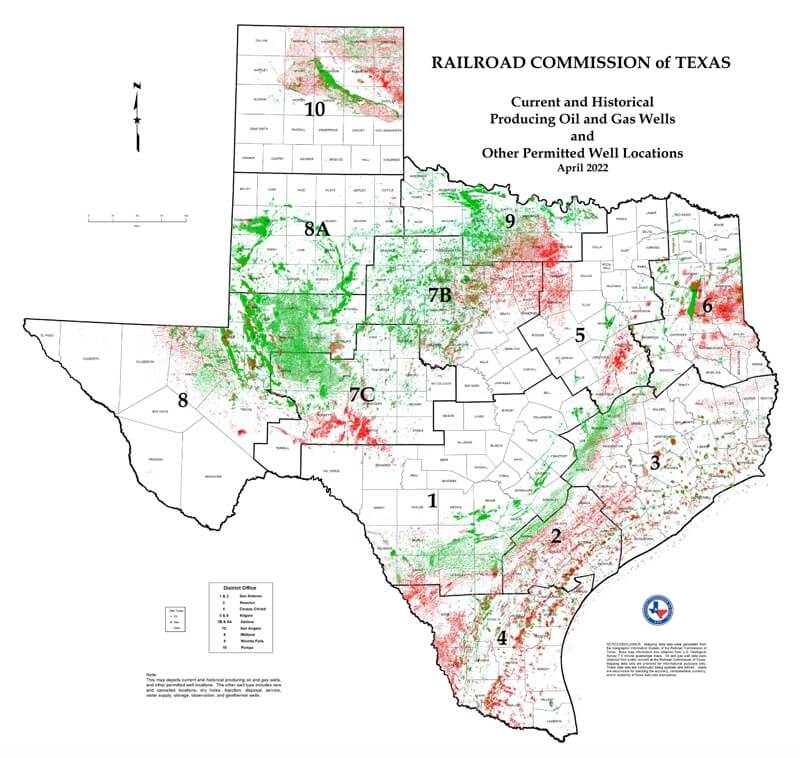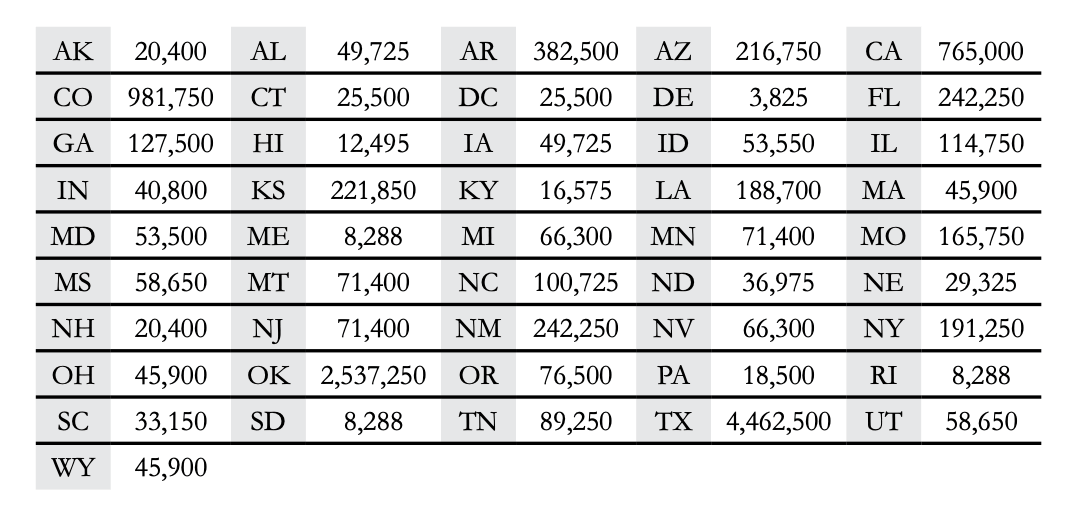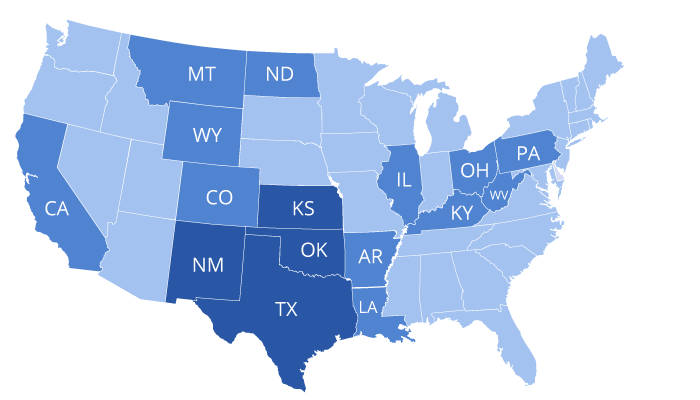Texas Mineral Rights
Learn about Texas mineral rights, the best locations, how to find your wells on a map, the value, transferring ownership, paying taxes, and more.
Sell Your Mineral Rights (Request an Offer):

Brief Overview
What are Texas Mineral Rights?
Texas mineral rights are a form of real property rights related to the ownership and control of minerals (such as oil, gas, coal, and metals) beneath the surface of a tract of land.
These rights can be owned separately from the surface land, meaning that one person can own the surface rights while another owns the underground mineral rights (two chains of title). There can also be dozens of mineral owners under a single tract of land.
In Texas, the mineral estate is dominant, allowing for the development (drilling and extraction) of oil and gas below the surface.
Owners of Texas mineral rights have the legal authority to mine, exploit, or produce any minerals found under the land’s surface. This can include the right to lease, sell, or gift these natural resources.
Ownership Lifecycle
Four Steps to Becoming a Texas Royalty Owner
Mineral rights can either be producing or non-producing. Producing minerals have an active oil or natural gas well that generates revenue. Non-producing minerals do not have active wells and therefore, do not produce revenue (and their owners do not receive royalty checks).
You own non-producing mineral rights in Texas.
A landman offers to lease your mineral rights.
You negotiate a lease and hope for a successful well.
If a successful well is drilled, you become a royalty owner and start receiving royalty checks!
Back to the Basics
Texas Mineral Rights
Texas is the top oil and gas-producing state in the county and is home to some of the most valuable mineral rights. Texas contains both older oil and gas fields with vertical wells and the four most prolific shale basins, including the Permian, Eagle Ford, Haynesville, and Barnett. Texas’s abundant natural resources make it one of the best states in which to own mineral rights.
About Texas Mineral Rights
As a Texas mineral owner, you may find the following topics informative and relevant to your mineral rights.
Top Producing Oil & Gas Counties in Texas
Texas has 255 counties, and almost all of them produce some amount of oil and gas. However, there are more than 70 counties that produce a significant amount of hydrocarbons. Is your county one of them?
How to Locate Your Texas Mineral Rights
Locating your Texas mineral rights on an interactive map is quite easy. We’ll walk you through the steps.
Texas Mineral Rights Value
The value of Texas mineral rights depends on a variety of factors, including location, production status, production volume, commodity price, lease development, lease terms, and the operator.
Find Your Texas Mineral Deed
Looking for proof that you own mineral rights? Follow these steps to search the deed records.
Texas Mineral Taxes
Texas mineral owners pay several types of taxes, including Ad Valorem taxes. Learn how to find your tax info and what happens if you don’t pay!
Sell Your Texas Mineral Rights
Get an offer for your Texas mineral rights. There is no obligation to sell, and it won’t cost you anything.

Image Description: Texas Railroad Commission Map showing current and historical oil and gas wells.

Image Description: Top oil and gas producing counties by production volume. Darker counties represent higher oil and gas production.
Best Locations
Top Texas Oil & Gas Producing Counties
We buy mineral rights in Texas. Minerals in the shale basins have the most prolific wells, but we will buy minerals anywhere in Texas. These are the top oil and gas producing counties in Texas:
|
|
NOTE: It is important to realize that, even in the top counties, there are areas of the county that produce vast amounts of oil and gas but other areas that produce none. Location is everything!
Horozontal Drilling
Texas Shale Basins
There are four main shale basins in Texas. Each has its own characteristics and has been developed at differing rates. Here is a breakdown of each shale basin.
Permian Basin
The Permian Basin is the largest oilfield in the United States. It contains the Delaware Basin, Midland Basin, and Central Uplift Platform. The Permian covers parts of West Texas and Southeast New Mexico. This area contains multiple stacked shale formations allowing for multiple wells targeting various formations.
Eagle Ford
The Eagle Ford shale is located in South Texas and has been heavily developed (drilled). Infill drilling is taking place, but there are very few new leases.
Barnett Shale
The Barnett shale was the first of the shale basins to be developed and ignited the Shale Boom with horizontal drilling an hydraulic fracturing techniques. There is very little new development in the Barnett Shale. Many of the royalty owners are homeowners will a tiny interest, making very little in royalty revenue.
Haynesville Shale
The Haynesville shale produces natural gas. Due to underground pressure, the wells are prolific during the first few months of production but quickly decline. The Haynesville is also in close proximity to Liquid Natural Gas (LNG) terminals in South Texas.
Image Description: EIA Map showing Texas shale basins.
RRC Interactive Map
Locating Your Texas Mineral Rights
When you see your mineral rights on a map, they become less abstract. The Texas Railroad Commission’s interactive map will also provide additional information about the wells on your property and the surrounding area. For example, you can view historical production volumes, operator history, newly permitted wells, and other relevant information.
You will need your legal descriptions to look up your Texas mineral rights. Your legal description can be found on your property deed or oil and gas lease.
Texas legal descriptions look something like this:
Section 20, Block C6, Public School Lands Survey, A-4892, Reeves County, Texas
Once you have the legal description, follow the video directions to locate your property.
Valuation Basics
Texas Mineral Rights Value
Texas mineral rights are valued differently if they are producing vs. non-producing.
Producing Texas Mineral Rights Value
“Producing minerals” are mineral rights with an active oil or gas well that is producing economically viable quantities of oil or gas.
Modern Valuation Method
Modern valuation methods use data from royalty statements and public sources to model future revenue based on various pricing scenarios. This method takes into account the production volumes, decline, deductions, and commodity prices. Most mineral buyers use this valuation method.
Rule of Thumb Valuation Method
In the past, they used to use the Rule of Thumb, which is roughly 30 – 60 months of royalty revenue based on a variety of factors.
Non-Producing Texas Mineral Rights Value
“Non-producing minerals” do not have a producing oil or gas well. Because there are no wells, there will be no royalty payments.
Typically, non-producing minerals are valued based on a multiple of the expected lease bonus.
For example, if the going lease bonus in the county ranges from $100-$500 dollars, you can expect to sell your mineral rights for the lease bonus times the number of net mineral acres (NMA) that you own.
The value of non-producing minerals is usually stated as a price per acre. The price per acre varies from state to state, county to county, and even within a county.
Interested in learning more about the value of your mineral rights? Check out this guide on 7 Factors That Influence the Value of Mineral Rights, or this video about why Location is Everything (via YouTube).
By the Numbers
Texas Mineral Owners Statistics
According to the National Association of Royalty Owners (NARO)
Royalty Owners in the United States
Texas Royalty Owners
Counties in Texas

Texas vs Other States
How Many Texans Own Oil & Gas Royalties?
Texas has more royalty owners than any other state. According to the National Association of Royalty Owners (NARO), there were 8.4 million Texas royalty owners in 2013. By 2021, that number had grown to 12.6 million and in 2024, that number is even higher.
The increase in royalty owners is due to the fractionalization of ownership (passing minerals from generation to generation with each generation getting a smaller portion).
Example:
Grandpa passed his Texas mineral rights to his 8 kids, who each passed the minerals to their kids, who passed them on to their children. In just three generations, mineral ownership can go from one owner to dozens of owners all sharing the revenue. Many wells have hundreds of partial owners.
County Records
Finding Your Texas Mineral Deed
The first step in being a responsible mineral owner is the know what you own so that it can be properly managed. There will come a time, either before you die or after, when the minerals will need to be transferred to the next generation or sold.
It’s a good idea to keep a copy of your mineral deed (and the previous deeds) in your files. Non-producing minerals tend to be “out of sight, out of mind” and are easily forgotten. Having a copy of your deed will help the next generation transfer all of the mineral rights.
Fortunately, TexasFile makes it easy to locate your mineral deed and other title documents related to your Texas mineral rights. Simply create an account and search the county records for your name and the names of the people from whom you inherited the mineral rights. Most of the time, you can search for free, and documents only cost $1 per page to download.
You might find conveyances, deeds, assignments, affidavits of heirship, lease memos, and other relevant documents.
If you’re thinking about your estate plan, you might find our guide, Four Things Older Mineral Owners Should Consider” to be thought-provoking.

Another Tax Burden
Paying Texas Mineral Taxes
Federal Taxes
All Texas oil and gas royalty owners pay federal income taxes on their royalty revenue.
State Taxes
Most mineral owners also pay state income taxes, but since Texas has no state taxes, Texas mineral rights owners are not taxed at the state level.
Property Taxes
Ad Valorem Taxes are county taxes that are paid on producing Texas mineral rights. If you don’t pay your Ad Valorem taxes, the county will auction your royalty interest! So, you want to keep your address current with both your operator and the county where the mineral rights are located (even if you are on direct deposit).
How do you check on your Texas property taxes?
Each county has a Central Appraisal District (CAD), so simply google:
[Your Mineral County] + “CAD”
For example, if your mineral rights are in Reeves County, Google “Reeves CAD.”
You should be able to find yourself in their online search results. If you are a new mineral owner, check the names of the person you inherited the minerals from.
Ownership Transfers
Transferring the Ownership of Mineral Rights in Texas
Transferring mineral rights in Texas is a process that involves legally passing the ownership of these rights from one party to another. Minerals can be transferred from an individual, estate, trust, or company.
Mineral rights are real property, so they are typically transferred by deed or court order (such as probate or a divorce). However, in Texas, mineral rights can sometimes be transferred with an Affidavit of Heirship (AOH).
These documents must be recorded with the county where the minerals are located, and if there are active oil or gas wells, the recorded documents must be sent to the operator with an owership transfer reuqest.
Texas Property Code 5.151 requires a mineral buyer to include specific language on deeds. This language is meant to reduce the number of mineral owners who are scammed or duped into selling their mineral rights (which used to be a big problem).
When a mineral owner passes away, their mineral rights are usually transferred to their heirs. It can cost thousands of dollars in legal fees to have the mineral rights transferred with the help of an attorney. Sometimes the cost is more than the value of the mineral rights.
It is often better to deed your mineral rights to the next generation (or sell them) before you pass away. Deeding mineral rights before your death may also help with estate planning and elder care needs.
Frequently Asked Questions
Texas Mineral Right FAQs
Texas has a rich oil and gas development history, resulting in more than 4.6 million people receiving royalty checks.
How long do mineral rights last in Texas?
In Texas, oil and gas mineral rights are typically owned until the owner dies or they are sold or deeded to another individual or entity. Typically mineral rights are passed from generation to generation, resulting in each generation owning a fraction of what the previous generation owned. Eventually, the mineral rights become very small and many are forgotten (or the heirs don’t find it worthwhile to transfer the interest).
What is a Mineral Deed?
A mineral rights deed is a legal document that conveys ownership of mineral rights from one party to another. Legal instruments conveying mineral rights can be called:
- Mineral Deed
- Royalty Deed
- Mineral & Royalty Deed
- Assignment of Overriding Royalty Interests
- Assignment of Royalty Interest
- Conveyand and Bill of Sale
- and more!
The title of the mineral conveyance partly depends on the type of mineral rights being conveyed. ORRIs and working interests are conveyed via an assignment while mineral interests, some royalty interests, and NPRIs are often conveyed with deeds.
Are mineral rights considered real property in Texas?
Yes, in Texas, mineral rights are considered “real property”. Property rights are known as a “bundle of sticks,” with each stick representing a type of property right. In Texas, the subsurface can be separated from the surface and owned by two different parties.
Can you sell mineral rights without owning the surface land?
Yes! Mineral rights are often severed from the surface and have their own chain of title (history of owners). You can sell your mineral rights without owning the surface. In fact, most mineral owners have never seen the oil and gas wells in which they own an interest!
How do I know if I own the mineral rights under my property?
When you purchased your property, the title company would have traced the ownership history for your property. They would know if your property is fee-simple or if the mineral rights were severed from the surface.
You can run a title search yourself by taking a trip to the County Clerk. They can help you locate your property deed and systematically trace the history of who owned the property before you. At some point in the title, you may see a reservation or conveyance of mineral rights.
It can be really challenging to run the title in popular oil and gas counties, so you may want to hire a landman to help.
How do I find out who owns the mineral rights under my property?
It can be difficult to figure out who owns the mineral rights under your property. Depending on how long ago the mineral rights were severed, there could be dozens of mineral owners. You can perform a title search yourself by tracking the title history back to the original land patent and then forward again to identify all of the owners and how much they own.
In some counties, this can be a really difficult task, and you may want to hire a landman to perform the title search for you. If you want to acquire the mineral rights under your property, this same landman can approach the mineral owners on your behalf and negotiate the purchase.
How do I get someone to drill an oil well on my Texas ranch?
This is a common question. Unless you are the only mineral owner and have several hundred thousand to several million dollars and the technical expertise to drill and operate a well, you probably cannot extract the oil and gas under your property. Instead, you will probably have to wait until a company approaches you with an offer to lease your mineral rights. This may or may not happen, depending on where your mineral rights are located. Most mineral owners never receive a lease offer.
If you really want to lease your mineral rights, your best bet is to contact the operators of nearby wells to see if they are interested.
What happens if I do not pay my mineral property taxes?
If you do not pay your mineral property taxes, the county will attempt to notify you that the taxes are delinquent. After some time, the county will file a suit against you (adding legal and court fees to your bill) and if you still don’t pay, then they will auction your royalty interest! So many mineral owners have lost their royalty interest this way, so it is really important to pay your property taxes on time every year!
Does Texas have a Dormant Mineral Act?
No, unlike many other states, Texas does not have a Dormant Mineral Act. This means that mineral rights never return to the surface owner unless they are specifically deeded back to the surface owner.
Can I buy Texas land with mineral rights?
Sure, but it may be difficult to find Texas property that is fee-simple (i.e. the mineral rights have never been severed from the surface). East Texas has the longest history of oil and gas development, so the mineral rights were often severed from the service long ago. Counties with newer development, particularly in the shale basins, have fewer owners and you are more likely to find land that has not been severed. However, you best bet for finding fee-simple land in Texas is to look in areas with very little oil or natural gas development.
Nationally Focused
Where We Buy Mineral Rights
We buy both producing and non-producing minerals in all oil and gas states. However, we are especially interested in Texas and Kansas mineral rights.
|
We even buy minerals in more obscure states, which produce very little oil and gas compared to other states.

Top Valuation Factors
How We Value Texas Mineral Rights
There are many factors that play into the value of mineral rights. These include location, producing vs. non-producing properties, current oil and gas prices, well production figures, lease terms, and even the operator of the well or wells. We also look at the risks of buying and owning minerals that you are interested in selling.
Location
Minerals in the hottest shale plays are more valuable than those in older fields with conventional wells.
Producing vs. Non-Producing
Producing minerals are often worth more than non-producing minerals because they are generating revenue.
Oil & Gas Prices
When oil and gas prices drop, revenue drops, and sometimes operators are unable to continue operating the well.
Production
Highly productive wells (and off-set wells) can increase the value of your minerals.
Lease Terms
Favorable lease terms (such as a 25% royalty reservation) positively impact the value of the leased minerals.
Operator
A small number of operators are unethical, and their reputation automatically devalues your minerals.
Multiple Factors
Why Sell Texas Mineral Rights?
Why People Sell Their Texas Mineral Rights
I am putting my affairs in order. I don’t want to burden my kids with the hassle of transferring ownership and managing small mineral rights. When my sister passed away, my niece and nephew had to hire an attorney to help them with the minerals. I don’t want my kids to go through that.
I inherited my mineral rights so they were sentimental, but I don’t really want to bother with managing them and filing extra tax returns. I decided to sell and use the money as a down payment on my house.
I had no idea how fast the oil production would decline. My checks are only 20% of what they were a few years ago. I should have sold my mineral rights when the wells were brand new and still generating huge royalties.
My oil wells have been producing for decades and the reserves are almost depleted. Once the wells are plugged, the value will be significantly lower. I’d rather cash out now.
I inherited mineral rights, but don’t want to be involved with fracking and fossil fuels. I would prefer to support renewable energy and do my part to reverse climate change.



